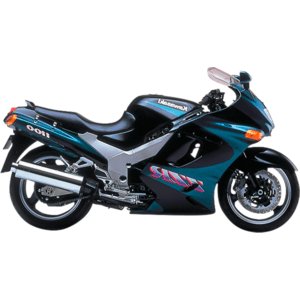Kawasaki ZZ-R 1100 [1990–1992]: The Speed King That Redefined Sport-Touring

Introduction
When Kawasaki unleashed the ZZ-R 1100 (known as the ZX-11 in North America) in 1990, it wasn’t just launching a motorcycle—it was declaring war on speed limits, aerodynamic inefficiency, and the very notion of compromise. For three years, this machine reigned as the fastest production motorcycle in the world, blending hyperbike performance with touring comfort in a way that left rivals scrambling to catch up. Even today, riding the ZZ-R 1100 feels like strapping into a time machine set to “unapologetic adrenaline.” Let’s dissect why this early ’90s legend remains a benchmark for power, innovation, and versatility.
Design & Ergonomics: Aerodynamics Meets Practicality

The ZZ-R 1100’s design was a masterclass in function-over-flamboyance. Its bulbous fairing, flush-mounted turn signals, and integrated front fender weren’t just styling exercises—they were wind-tunnel honed tools to slice through air resistance. Kawasaki claimed a 10% reduction in drag compared to its predecessor, the ZX-10, and you feel it immediately at speed. The cockpit envelops the rider in a surprisingly roomy ergonomic package: the seat height (780 mm / 30.7 in) is low enough for shorter riders, while the semi-upright handlebars and spacious tank recesses allow for a sport-touring stance that doesn’t punish wrists or knees.
Practical touches abound: dual trip meters, bungee hooks under the seat, and a centerstand (a rarity on bikes this performance-focused). The 21-liter (5.5-gallon) fuel tank ensures range, though spirited riding can drop fuel efficiency to 15 km/l (35 mpg). Heat management is a minor gripe—the engine’s right side radiates warmth in traffic—but the fairing does an admirable job deflecting windblast even at triple-digit speeds.
Engine & Performance: Ram-Air Revolution
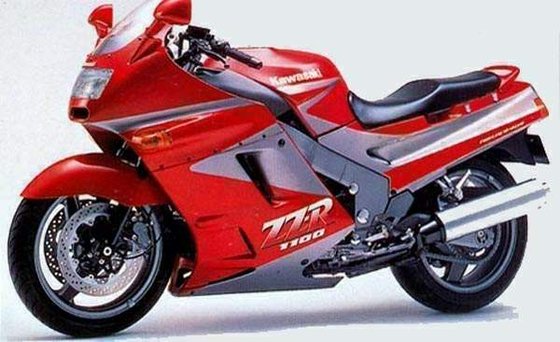
At the heart of the ZZ-R 1100 lies its pièce de résistance: a 1052cc inline-four with Kawasaki’s pioneering ram-air induction. This wasn’t just marketing fluff. Air rushing through the fairing’s nose duct pressurized the airbox, effectively “supercharging” the engine as speed increased. The result? A claimed 147 hp (108 kW) at 10,500 rpm—though dyno tests often showed rear-wheel figures closer to 139 hp.
Twist the throttle, and the ZZ-R transforms physics into theater. Below 4,000 rpm, it’s docile, almost sleepy. But cross 5,000 rpm, and the world bends: the inline-four howls with a metallic snarl, thrust builds exponentially, and the horizon rushes closer like a rewound VHS tape. By 7,000 rpm, you’re vaulting forward at a rate that still embarrasses modern liter bikes, all the way to its 285 km/h (177 mph) top speed. The six-speed gearbox (with a delightably precise shifter) and tall gearing make 160 km/h (100 mph) feel like a casual cruise—the tach barely cresting 6,000 rpm in sixth gear.
Key Performance Figures:
- 0–100 km/h (0–62 mph): 3.1 seconds
- Standing ¼ mile: 10.1 seconds @ 217 km/h (135 mph)
- Top speed: 285 km/h (177 mph) (unrestricted, per Cycle World tests)
- Fuel range: ~320 km (200 miles) at moderate pace
Handling & Braking: Heavyweight Ballet
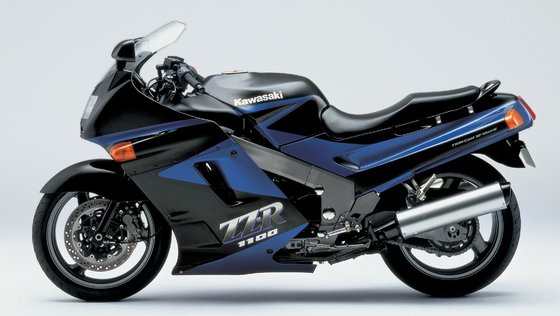
Weighing 270 kg (595 lbs) wet, the ZZ-R isn’t a flickable canyon carver—but it defies its mass with shocking elegance. The aluminum perimeter frame and 43mm adjustable forks (120mm / 4.7in travel) provide telepathic front-end feedback, while the fully adjustable Uni-Trak rear shock keeps the 170-section Dunlop radial planted. Steering is neutral, requiring deliberate input mid-corner but rewarding with rock-solid stability.
Braking? Dual 320mm discs up front with four-piston calipers offer fade-resistant bite, hauling the ZZ-R from 100 km/h (62 mph) to zero in 37 meters (121 ft). The rear 240mm disc is more than adequate for trail braking.
Competition: The ’90s Hyperbike Showdown
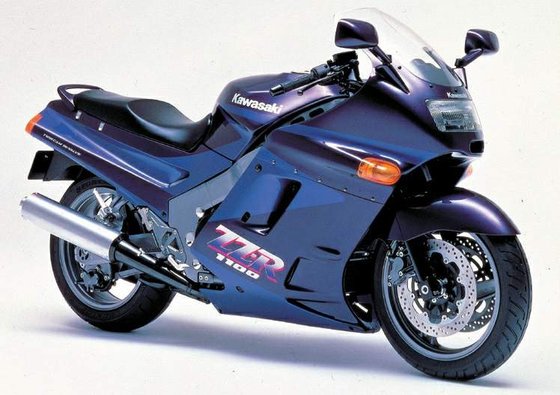
In its era, the ZZ-R 1100 faced three rivals:
- Yamaha FZR1000 (1987–1995): Lighter (227 kg / 500 lbs) and sharper in corners, the FZR’s 135 hp engine couldn’t match the Kawasaki’s top-end rush. A better track tool, but less refined for touring.
- Suzuki GSX-R1100 (1986–1998): Raw, unfiltered power (142 hp) and a cult following, but punishing ergonomics and dated oil-cooling left it feeling primitive next to the ZZ-R.
- Honda CBR1000F (1987–1996): The “Hurricane” prioritized comfort over outright speed (125 hp). Plush suspension and Honda reliability, but outgunned in every drag race.
The ZZ-R’s genius was straddling these extremes—it devoured autobahns like the Honda, cornered nearly as well as the Yamaha, and matched the Suzuki’s adrenaline quotient while adding civility.
Maintenance: Keeping the Legend Alive
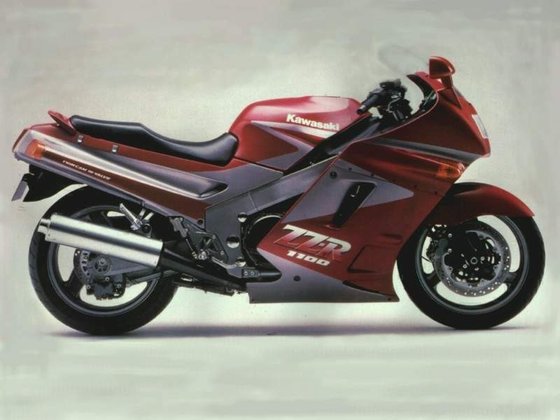
Owning a 30-year-old hyperbike demands vigilance. Here’s what ZZ-R 1100 owners should prioritize:
1. Valve Adjustments
- Intake valves: 0.13–0.18 mm (0.005–0.007 in)
- Exhaust valves: 0.18–0.23 mm (0.007–0.009 in)
Check every 6,000 km (3,700 miles). Shims wear quickly due to high-revving DOHC design.
2. Carburetor TLC
The Keihin CVKD40 carbs are reliable but sensitive to ethanol-blended fuels. Use MOTOPARTS.store’s carb rebuild kits ($89.99) annually if ridden sporadically.
3. Oil & Cooling
- Oil capacity: 3.5L (3.7 qts) with filter. Use 10W-40 synthetic (MOTOPARTS.store brand: $12.99/L).
- Coolant: Replace every 2 years with ethylene glycol mix (2.5L / 2.6 qts).
4. Brake System
- Front pads: Replace when worn to 1mm. Upgrade to MOTOPARTS.store sintered pads ($45/pair) for better bite.
- Brake fluid: Flush with DOT 4 annually.
5. Chain & Sprockets
The 110-link chain and 17/45 sprockets endure abuse but check tension every 1,000 km (620 miles). MOTOPARTS.store’s X-Ring Chain Kit ($219) adds longevity.
Conclusion: The Uncompromised Icon
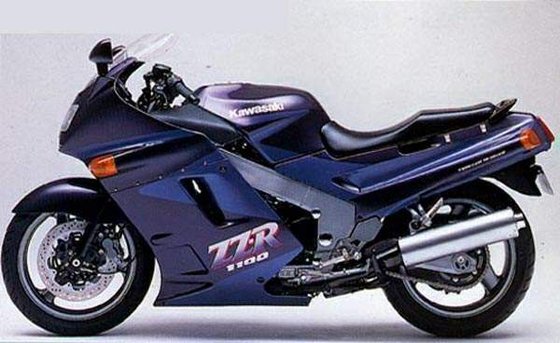
The ZZ-R 1100 wasn’t just fast—it was visionary. Its ram-air engine blueprint became industry standard, its aluminum frame set the template for sport-touring chassis, and its blend of brutality and refinement remains unmatched. Riding one today isn’t nostalgia; it’s a masterclass in engineering audacity.
For owners, MOTOPARTS.store carries every gasket, bearing, and upgrade to keep your ZZ-R dominating backroads and earning thumbs-ups at bike meets. Because legends deserve immortality—one thrilling mile at a time.
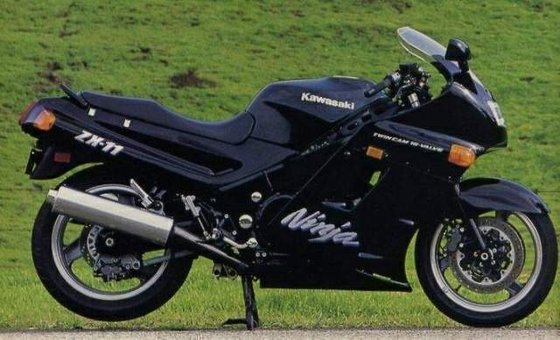


Specifications sheet
| Engine | |
|---|---|
| Stroke: | Four-stroke |
| Ignition: | Battery and coil (transistorized) |
| Max power: | 108 kW | 145.0 hp |
| Max torque: | 110 Nm |
| Fuel system: | 4x Keihin CVKD40 carburetors |
| Lubrication: | Forced lubrication (wet sump with cooler) |
| Max power @: | 10500 rpm |
| Displacement: | 1052 ccm |
| Max torque @: | 8500 rpm |
| Configuration: | Inline |
| Cooling system: | Liquid cooled |
| Compression ratio: | 11.0:1 |
| Number of cylinders: | 4 |
| Dimensions | |
|---|---|
| Wheelbase: | 1490 mm (58.2 in) |
| Dry weight: | 228 |
| Wet weight: | 264 |
| Seat height: | 780 mm (30.7 in) |
| Overall width: | 720 mm (29.3 in) |
| Overall height: | 1210 mm (47.6 in) |
| Overall length: | 2165 mm (85.24 in) |
| Ground clearance: | 110 mm (4.33 in) |
| Fuel tank capacity: | 21 L (5.5 US gal) |
| Drivetrain | |
|---|---|
| Gear Ratio: | {'1st': '2.800 (42/15)', '2nd': '2.055 (37/18)', '3rd': '1.590 (35/22)', '4th': '1.333 (32/24)', '5th': '1.153 (30/26)', '6th': '1.035 (29/28)'} |
| Final drive: | chain |
| Chain length: | 110 |
| Transmission: | 6-speed |
| Rear sprocket: | 45 |
| Front sprocket: | 17 |
| Maintenance | |
|---|---|
| Rear tire: | 170/60-17 |
| Engine oil: | 10W40 |
| Front tire: | 120/70-17 |
| Brake fluid: | DOT 4 |
| Spark plugs: | NGK CR9E or NGK CR9EIX |
| Spark plug gap: | 0.7 |
| Coolant capacity: | 2.5 |
| Forks oil capacity: | 0.78 |
| Engine oil capacity: | 3.5 |
| Engine oil change interval: | Every 5000 km or 2 years |
| Valve clearance (intake, cold): | 0.13–0.18 mm |
| Valve clearance check interval: | 24,000 km / 15,000 mi |
| Valve clearance (exhaust, cold): | 0.18–0.23 mm |
| Recommended tire pressure (rear): | 2.9 bar (42 psi) |
| Recommended tire pressure (front): | 2.9 bar (42 psi) |
| Chassis and Suspension | |
|---|---|
| Frame: | Pressed aluminium perimeter |
| Rear tire: | 170/60 v- 17 |
| Front tire: | 120/70 v- 17 |
| Rear brakes: | Single 240 mm disc, 1-piston caliper |
| Front brakes: | Dual 320 mm discs, 4-piston calipers |
| Rear suspension: | Monoshock fully adjustable |
| Front suspension: | 43mm telescopic fork, preload and rebound adjustable |
| Rear wheel travel: | 112 mm (4.4 in) |
| Front wheel travel: | 120 mm (4.7 in) |
| Additional Specifications | |
|---|---|
| Battery: | 12V 12Ah YTX14-BS |
| Top speed: | 285 km/h (177 mph) |
| Idle speed: | 1000 ± 50 rpm |
| Quarter mile time: | 10.1 sec @ 217.3 km/h (135.54 mph) |
| Carburetor adjustment: | 2.0 turns out (Vergaserluftschraube) |



